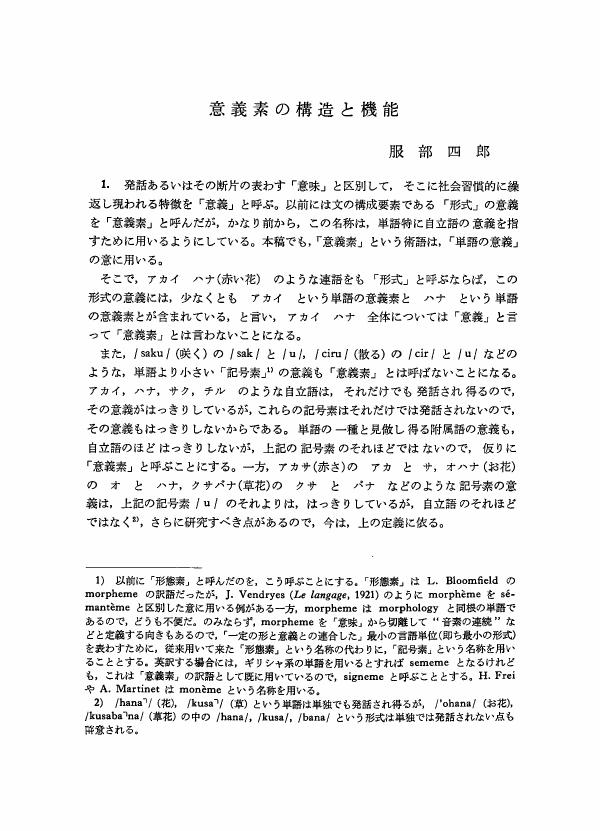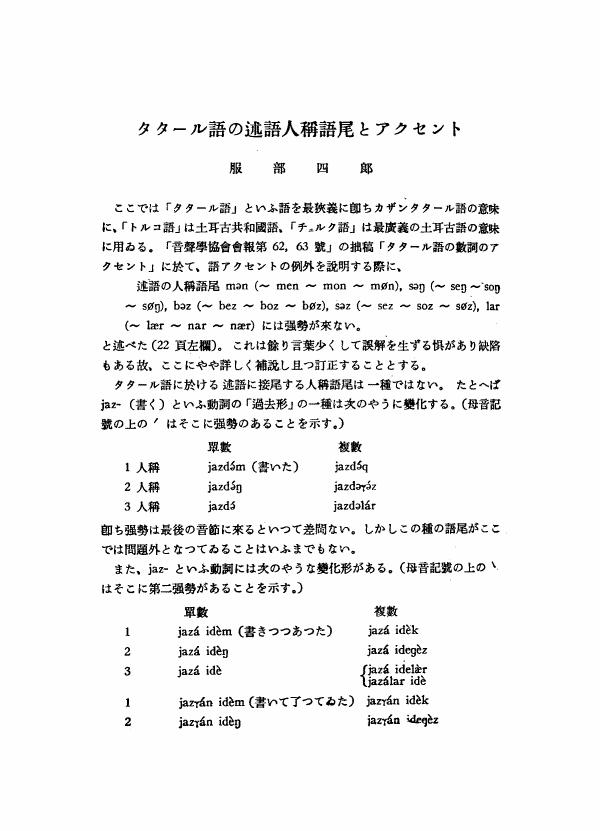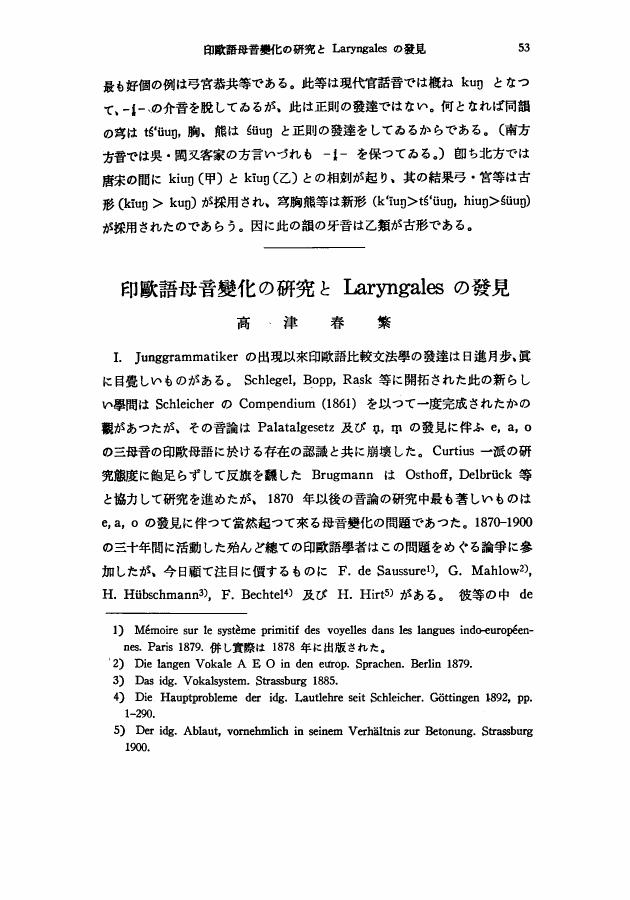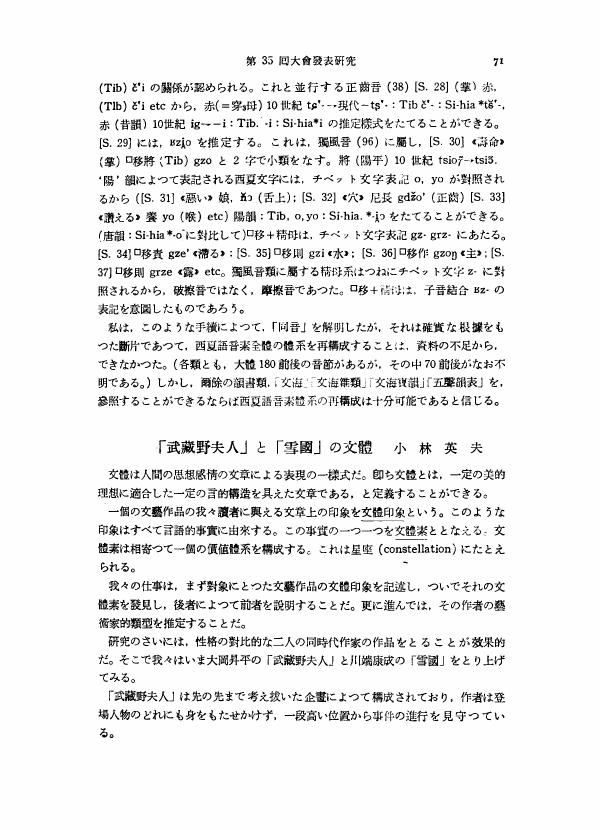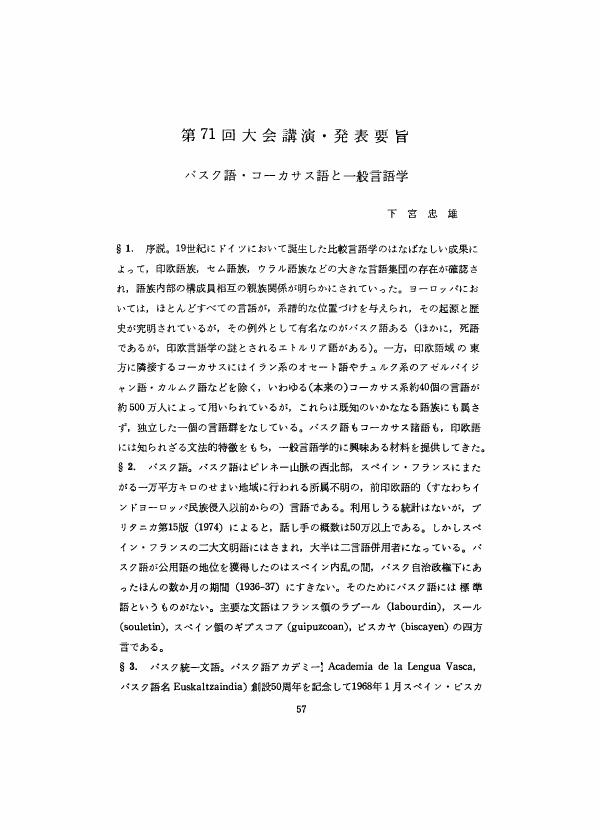2 0 0 0 OA アルタイ諸言語(含朝鮮語)と日本語
- 著者
- 板橋 義三
- 出版者
- 日本言語学会
- 雑誌
- 言語研究 (ISSN:00243914)
- 巻号頁・発行日
- vol.2001, no.120, pp.106-116, 2001-12-25 (Released:2007-10-23)
- 参考文献数
- 15
2 0 0 0 OA カナダ・エスキモー語の動詞形成法
- 著者
- 田村 すヾ子
- 出版者
- 日本言語学会
- 雑誌
- 言語研究 (ISSN:00243914)
- 巻号頁・発行日
- vol.1978, no.73, pp.84-88, 1978-03-31 (Released:2010-11-26)
2 0 0 0 附属語と附属形式
- 著者
- 服部 四郎
- 出版者
- 日本言語学会
- 雑誌
- 言語研究 (ISSN:00243914)
- 巻号頁・発行日
- vol.1950, no.15, pp.1-26,103, 1950
The writer of this article classifies linguistic forms as follows _??_ is definition of various forms is as the following:<BR>A form which is never uttered separately (by means of pauses) from other. form (s) is a bound form; all others are free forms. A free form which cannot be uttered alone is a clitic; all others are independent forms.<BR>It is sometimes difficult, however, to distinguish clitics bound forms, because clitics are. generally, although not always, uttered jointly with other form (s)<BR>The author explains first how to identify various fractions of utterances as the same form. Then he proposes three points..s the criteria to determine whether a form-is a clitic or a bound form.<BR>I) If the form in question can be co: ined freely with various independent forms, which belong to different classes because their functions and inflections are different, it, is a free form, i. e. a clitic.<BR>2) If other word (s) or phrase (s) can be inserted freely. between two forms united semantically, both of them are free forms Accordingly the form in question is-a. clitic.<BR>3) If two forms combined can change their order of combination, the two forms are free forms. The phonological structure of a form cannot be utilised as a criterion, because many clitics have similar structtres to those of bound forms. Of course we cannot depend upon the_meaning, too.<BR>It must be noticed, however, that clitics have such phonological‘ structures as can be uttered separately from other forms, and they are very ‘regular’ in relation to the words, with which they enter into close combinations. Ehglish ’-s of the possessive case is a bound form, because it has not such a phonological structure as can be uttered alone. The-e of Latin puellae is a bound form, because i t is not regular. Compare puerT, hostis, cornas, diei.
2 0 0 0 OA 意義素の構造と機能
- 著者
- 服部 四郎
- 出版者
- 日本言語学会
- 雑誌
- 言語研究 (ISSN:00243914)
- 巻号頁・発行日
- vol.1964, no.45, pp.12-26, 1964-03-30 (Released:2010-11-26)
- 参考文献数
- 12
2 0 0 0 カチン語の研究--バモ方言の記述ならびに比較言語学的考察
- 著者
- 西田 竜雄
- 出版者
- 日本言語学会
- 雑誌
- 言語研究 (ISSN:00243914)
- 巻号頁・発行日
- no.38, 1960-09
2 0 0 0 カチン語の研究 バモ方言の記述ならびに比較言語学的考察
- 著者
- 西田 龍雄
- 出版者
- 日本言語学会
- 雑誌
- 言語研究 (ISSN:00243914)
- 巻号頁・発行日
- vol.1960, no.38, pp.1-32, 1960
2 0 0 0 OA プラーグ学派の言語観 (Ппажская лингвическая школа)
- 著者
- 千野 (Чино) 栄一 (Эйичи)
- 出版者
- 日本言語学会
- 雑誌
- 言語研究 (ISSN:00243914)
- 巻号頁・発行日
- vol.1972, no.61, pp.1-16, 1972-03-30 (Released:2010-12-22)
- 参考文献数
- 45
В Ппажской лингвистической школе существуют два основных направления исследования языка, которые друг друга дополняют. Целью исследования одного из этих направдений явдяется структуральность языка, т. е.представление о языке как о Функциональной системе. Это направление хорошо известно во всем лингвистическом мйре заслугой трудов Н. С. Трубецкого, Р. О. Якобсона и других.Целью исследования другого направления является ограничение этой структуральмости.Труды чешских лингвистов часто касаются этого направления, значение которнго очень важно для современной лингвистики.(.Б, Гаврвнек, Я. Мукаржовский, Б. Трнка и лр. особенно В.Мтезиус и из русских лингвистов С.Карцевский.)Теория этой школы холы хорошо построена и не теряет эначение и в современной лингвистике, потому что в основе теории лежат два аспекта, находящиеся в противоречии.В стремлении устранить это противоречие заключается значение этой школы.
2 0 0 0 言語島奈良県十津川方言の性格
- 著者
- 平山 輝男
- 出版者
- 日本言語学会
- 雑誌
- 言語研究 (ISSN:00243914)
- 巻号頁・発行日
- no.76, pp.p29-73, 1979
2 0 0 0 OA 現代語の形容詞語幹型感動文の構造
- 著者
- 清水 泰行
- 出版者
- 日本言語学会
- 雑誌
- 言語研究 (ISSN:00243914)
- 巻号頁・発行日
- vol.148, pp.123-141, 2015 (Released:2016-05-17)
- 参考文献数
- 40
この論文は,「熱っ!」のように,形容詞語幹が声門閉鎖を伴って発話され,感動の意味が表現上実現する文(形容詞語幹型感動文と呼ぶ)を扱い,「感動の対象」を表す「主語」をとるかとらないかに着目して考察する。その結果として,形容詞語幹型感動文について,①即応性と対他性による分析から,構造上の「主語」をとらないと考えられること,②「これうまっ!」における「これ」のような形式は,話し手が聞き手に注意喚起を呼び掛けるための「感動の対象」の提示部であること,③形容詞語幹型感動文を構成する形容詞の性質の違い(属性形容詞か感情形容詞か)の観点から,属性形容詞によるものと感情形容詞によるものの二種に大別できること,④属性形容詞によるものも感情形容詞によるものも体言化形式を持ち,名詞句として感動の表出に用いられることで同じ感動文として機能すること,という四点を述べる*。
2 0 0 0 OA タタール語の述語人稱語尾とアクセント
- 著者
- 服部 四郎
- 出版者
- 日本言語学会
- 雑誌
- 言語研究 (ISSN:00243914)
- 巻号頁・発行日
- vol.1941, no.7-8, pp.68-82, 1941-04-30 (Released:2010-11-26)
- 参考文献数
- 5
- 著者
- 田中 聡子
- 出版者
- 日本言語学会
- 雑誌
- 言語研究 (ISSN:00243914)
- 巻号頁・発行日
- vol.1996, no.110, pp.120-142, 1996
This paper presents an analysis of the polysemic structure of the verb'mire (see)'. The word is used with various meanings. But all of its meanings, including those which seem to be arbitrarily extended, can be proved to be motivated and characterized by the nature of human cognition.Its meanings are not discrete but in their typical uses they are discernable by semantic features. The fundamental meaning (m.1) of 'mire'may be expressed in terms of the semantic features: <visual‹ <perception› . This assumption is supported by the fact that it is usually received in this meaning when it lacks the object word i.e. in the default case.The other meanings can be accounted for based on three principles of derivation which can be said to be psychologically valid: (1) incorporation of interpretive inferences into lexical meaning, (2) metaphor, and (3) metonymy.principle (1) ...... m.2: <visual‹ <perception› <judgement‹ ; m.3: <judgement› ; m.4: <visual‹ <perception› <judgement‹ <taking measures›principle (2) ...... m.5: <non-visual‹ <perception› <judgement‹principle (3) ...... m.6: varying from <experience of a state of affairs› to <occurrence of a state of affairsThe variations of m.6 reflect the degrees of "subjectification"(Langacker 1990: 316) of the viewer construed by the conceptualizer.
2 0 0 0 OA 印欧語母音愛化の研究とLaryngalesの發見
- 著者
- 高津 春繁
- 出版者
- 日本言語学会
- 雑誌
- 言語研究 (ISSN:00243914)
- 巻号頁・発行日
- vol.1939, no.3, pp.53-76, 1939-09-25 (Released:2010-11-26)
- 参考文献数
- 73
2 0 0 0 OA 標準語形普及の3段階
- 著者
- 井上 史雄
- 出版者
- 日本言語学会
- 雑誌
- 言語研究 (ISSN:00243914)
- 巻号頁・発行日
- vol.2004, no.126, pp.39-68, 2004-12-25 (Released:2007-10-23)
- 参考文献数
- 26
In this paper a new technique for representing dialectal differences will be introduced. Two techniques of simplification are applied to represent geographical distribution patterns of standard Japanese. The first one is a representation of two-dimensional geographical distribution patterns by one dimension. The second one is plotting the geographical locations making use of railway distances from cultural centers. By simplifying the two-dimensional geographical distribution into one by railway distance, another dimension can show the average percentage of usage of standard Japanese forms for each prefecture. In order to see the patterns of distribution of the Japanese standard forms, “Kasai data”, or numerical data of the “Linguistic Atlas of Japan”, was utilized.By comparing railway distances from Tokyo and from Kyoto in the form of scattergrams, the degree of linguistic influence of each of the capitals of Japan was analyzed. The overall pattern showed that railway distances surely correspond to standardization of dialects. The standardization of language in Japan proceeded in two historical stages. The first stage was standardization from Kyoto. The second stage appeared later from Tokyo. These two stages were-ascertained by classifying 82 words into 4 clusters. West cluster words showed Kyoto-centered diffusion and east cluster words showed Tokyo-centered diffusion.An analysis of younger Japanese people through a countrywide postal survey showed that standardization has proceeded with greater speed in recent years. Most of the words of the Kasai data approached the end of diffusion. This third stage of standardization seems to have been influenced by the mass media.
- 著者
- 黒田 成幸
- 出版者
- 日本言語学会
- 雑誌
- 言語研究 (ISSN:00243914)
- 巻号頁・発行日
- no.129, pp.91-134, 2006-03
1 0 0 0 OA Negをc-統御する不定語+モ
- 著者
- 片岡 喜代子
- 出版者
- 日本言語学会
- 雑誌
- 言語研究 (ISSN:00243914)
- 巻号頁・発行日
- vol.131, pp.77-113, 2007 (Released:2022-03-08)
- 参考文献数
- 53
日本語で文否定要素(Neg)を必要とする不定語+モ「だれも/なにも」は,英語のNPIのany-と同様,否定とともに全称否定解釈を導くので,any-の対応物としてLFでのNegによるc-統御がその必要条件と見なされてきた.また最近のWatanabe(2004)において,イタリア語等の否定環境に現れる不定語と同様にそれ自体否定力を持った要素であるという分析も提示された.本研究では,まず,同じくNegを要求する「シカ」句とそれら不定語+モの相互作用の現象に基づき,不定語+モは,LFでNegにc-統御されてはならないこと,また,それ自体否定力を持たないことを示し,それら先行の分析が不適切であることを示す.その上で,「シカ」句との相互作用の現象に基づいて,不定語+モを含む名詞句全体が全称量化を導く表現であり,それ故に,全称否定を導くためにはLFでNegをc-統御しなければならないことを主張する.
1 0 0 0 OA 「武藏野夫人」と「雪國」の文體
- 著者
- 小林 英夫
- 出版者
- 日本言語学会
- 雑誌
- 言語研究 (ISSN:00243914)
- 巻号頁・発行日
- vol.1957, no.31, pp.71-72, 1957-03-31 (Released:2010-11-26)
1 0 0 0 OA アイヌ語の連體詞
- 著者
- 知里 眞志保
- 出版者
- 日本言語学会
- 雑誌
- 言語研究 (ISSN:00243914)
- 巻号頁・発行日
- vol.1941, no.7-8, pp.112-146, 1941-04-30 (Released:2010-11-26)
1 0 0 0 OA 現代九州諸方言における旧上二段動詞の「下二段化」は九州・琉球祖語仮説を支持するか?
- 著者
- 五十嵐 陽介
- 出版者
- 日本言語学会
- 雑誌
- 言語研究 (ISSN:00243914)
- 巻号頁・発行日
- vol.163, pp.1-31, 2023 (Released:2023-02-09)
- 参考文献数
- 63
現代九州諸方言には,旧上二段動詞の未然・連用形末が母音eを取り旧下二段動詞と統合する,いわゆる「下二段化」が観察される。九州・琉球祖語仮説によるとこの特質は,九州諸方言と琉球諸語がともに経験した音変化の結果であり,この音変化の共有によって九州諸方言と琉球諸語からなる単系統群が定義されるという。しかしながら「下二段化」は音変化ではなく類推変化の可能性が残されている。本稿は,九州諸方言の系統的位置の観点から現代九州諸方言の旧上二段動詞を分析することによって,九州・琉球祖語仮説の妥当性を検討した。その結果,この仮説を支持する証拠が宮崎県中部の方言に認められることを明らかにした。さらに,その他の現代九州諸方言も九州・琉球祖語の子孫とみなしうることを論じた。
1 0 0 0 OA 第71回大会講演・発表要旨
1 0 0 0 OA 日本語受動の類型論
- 著者
- 宮腰 幸一
- 出版者
- 日本言語学会
- 雑誌
- 言語研究 (ISSN:00243914)
- 巻号頁・発行日
- vol.157, pp.113-147, 2020 (Released:2020-12-10)
- 参考文献数
- 34
本稿は日本語受動の新たな類型論を提案・実証する。主な提案は次の7つである。[I]日本語受動は[1]受影主受動と[2]経験主受動に大別され,それぞれさらに下位分類される。[II]ラレルは2(+1)項助動詞であり,意味と統語の両レベルで[1]よりも[2]の方が階層的に上位の構造を持ち,[2]の中でもあるタイプ([A]直接・[B]所有1)よりも別のタイプ([C]所有2・[D]間接)の方がより複雑な構造を持っている。[III]すべてのタイプにおいて意味レベルの束縛が重要な役割を果たす。[IV]受動の本質的特性である〈受影性〉は6つの認可条件と3つの階層で複合的に規定される。[V]日本語受動の典型は[2A]タイプであり,それは主体的把握・内界表出文である。[VI]それがプロトタイプであることは三重受影性階層から定理として導き出される。[VII]非典型的なタイプも,受影主や複合事象/複雑述語文の一般的な派生度測定基準/方法の導入により,原理的に説明される。


